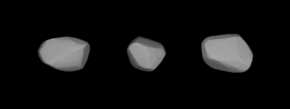516 Amherstia
 A three-dimensional model of 516 Amherstia based on its light curve | |
| Discovery | |
|---|---|
| Discovered by | Raymond Smith Dugan |
| Discovery date | 20 September 1903 |
| Designations | |
| (516) Amherstia | |
Named after | Amherst College |
| 1903 MG; 1938 YO | |
| Main belt | |
| Orbital characteristics [1] | |
| Epoch 31 July 2016 (JD 2457600.5) | |
| Uncertainty parameter 0 | |
| Observation arc | 112.26 yr (41003 d) |
| Aphelion | 3.4103 AU (510.17 Gm) |
| Perihelion | 1.95161 AU (291.957 Gm) |
| 2.68094 AU (401.063 Gm) | |
| Eccentricity | 0.27204 |
| 4.39 yr (1,603.4 d) | |
| 26.3259° | |
| 0° 13m 28.308s / day | |
| Inclination | 12.960° |
| 328.839° | |
| 257.966° | |
| Physical characteristics | |
| 65.144±0.380 km[1][2] 41.9±3.3 km[3] | |
| Mass | (4.7 ± 2.04/1.46)×1017 kg[2] |
Mean density | 3.246 ± 1.408/1.011 g/cm3[2] |
| 0.312 d [4] 7.4842 h (0.31184 d)[1] | |
| 0.163–0.173[5] 0.202±0.015[1] | |
| M-type asteroid | |
| 8.40[1] | |
516 Amherstia was the 8th asteroid discovered by Raymond Smith Dugan, and was named after Amherst College, his alma mater. Amherstia is a large M-type main belt asteroid, with an estimated diameter of 73 km. It follows an eccentric orbit between Jupiter and Mars, with an orbital period of 4.39 years. The orbital plane is inclined at an angle of 13° to the ecliptic.
In 1989, the asteroid was observed from the Collurania-Teramo Observatory, allowing a light curve to be produced that showed an estimated rotation period of 7.49 hours and a brightness variation of 0.25 ± 0.01 in magnitude.[6] On January 14, 2002, Amherstia was observed to occult the seventh-magnitude star SAO 60107 from ten sites in Florida. The measured timing chords were used to estimate a cross-section diameter of 41.9±3.3 km with a generally circular profile.[3] The near infrared spectra of Amherstia suggests a surface consisting of a single mafic silicate with iron–nickel alloy. The infrared albedo is 16%.[7]
References
- ^ a b c d e Yeomans, Donald K., "516 Amherstia", JPL Small-Body Database Browser, NASA Jet Propulsion Laboratory, retrieved 8 May 2016.
- ^ a b c Fienga, A.; Avdellidou, C.; Hanuš, J. (February 2020). "Asteroid masses obtained with INPOP planetary ephemerides". Monthly Notices of the Royal Astronomical Society. 492 (1). doi:10.1093/mnras/stz3407.
- ^ a b Bookamer, R.; Povenmire, H.; Povenmire, K. I. (March 2003), "The Occultation of SAO 60107 by (516) Amherstia on Jan. 14, 2002", 34th Annual Lunar and Planetary Science Conference, March 17–21, 2003, League City, Texas, Bibcode:2003LPI....34.1203B, 1203.
- ^ 1 Archived 27 November 2005 at the Wayback Machine
- ^ 2 Archived 16 December 2004 at the Wayback Machine
- ^ Dotto, E.; et al. (June 1992), "M-type asteroids - Rotational properties of 16 objects", Astronomy and Astrophysics Supplement Series, 95 (2): 195–211, Bibcode:1992A&AS...95..195D.
- ^ Hardersen, Paul S.; Gaffey, M. J.; Abell, P. A. (September 2006), "Near-infrared Reflectance Spectra Of 135 Hertha, 224 Oceana, 516 Amherstia, And 872 Holda", Bulletin of the American Astronomical Society, 38: 626, Bibcode:2006DPS....38.7103H.
External links
- 516 Amherstia at AstDyS-2, Asteroids—Dynamic Site
- 516 Amherstia at the JPL Small-Body Database
